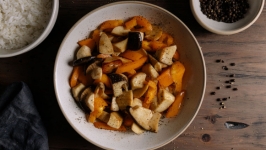Pickling Particulars
Pickled or fermented
Pickling most often refers to the immersion of food in an acidic solution such as vinegar, while fermented “pickles” are not pickled at all. Instead, fermentation involves adding salt to food to kill the bad bacteria while promoting the growth of good bacteria called lactobacilli, which serves to preserve the food.
Right as ratios
To make pickles, keep it safe by ensuring that the percentage of vinegar to water is no less than 50 per cent. That’s not to say it can’t be more if you prefer a puckery pickle. Also, make sure you are using vinegar that is at least 5 per cent acetic acid — anything less will make the mixture too alkaline. Distilled white vinegar, wine vinegar or apple cider vinegar all make good choices.
For fermented pickles, aim for a brine in the region of 2 to 3 per cent salt to water (for 4 cups of water, add about 2 tablespoons of salt). Like any fermented products, make sure that the brine covers the food at all times and that the jars are occasionally “burped” to release the gas.
Use that brine
Have you emptied that jar of pickles you really like? Add fresh cucumbers to that brine and pop it in the fridge and wait a few days before snacking on them. Or whisk ¼ cup brine with ½ cup oil for a quick salad dressing. Add a couple of spoonfuls to your next caesar, martini or soak chicken in the brine overnight before dredging it in flour to make fried chicken for your next picnic.
Look beyond the cucumber
There are so many things that can be pickled in this abundant season. Fennel makes a fantastic pickle, as do peppers, radishes, celery root and tomatoes. You can also try a mix of vegetables, like our take on an Italian giardiniera, shown here. And don’t forget about fruit — pickled fruit such as umeboshi, Japanese sour plums, makes a great condiment.
Quick Pickled Peppers
Pick up a pint of plucky peppers to make a pleasant pickle. Use an array of mild peppers with a few hotter ones added for varied flavour, and you'll want to put them on everything.
Instead of canning these peppers in a water bath, do a quick pickle and keep them in the fridge, so they stay crunchy.
1¼ lbs mixed peppers such as Hungarian Wax, Anaheim, poblano, jalapeño, serrano
½ teaspoon whole cumin seeds
½ teaspoon whole coriander seeds
½ teaspoon allspice berries
1½ cups champagne vinegar
½ cup water
3 tablespoons sugar
1 teaspoon sugar
Sterilize 2 pint jars and add ¼ teaspoon each of cumin, coriander and allspice to each jar. Chop the milder peppers (poblano, Hungarian,
Anaheim) into rings and pack them into the jars. Slice the hotter peppers (jalapeño and serrano) lengthwise into quarters. Remove seeds and veins from the hotter peppers, if you desire a less spicy mix. And it's never a bad idea to wear gloves to protect your hands while handling the hot ones.
Place the quartered hot peppers down along the sides of the jars, using a wooden spoon to pack down, as necessary.
Meanwhile heat the vinegar, water and sugar until just below the boil, whisking a few times to dissolve the sugar and salt. Transfer the hot liquid to a heatproof jug, and pour over each jar leaving ½-inch head space at the top of the jar. Seal the jars and allow to cool at room temperature.
Once cool, place them in the refrigerator where they will keep for abou rovided you don’t eat them all first.








